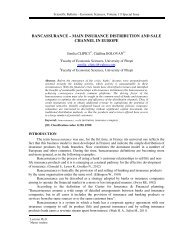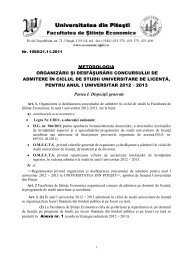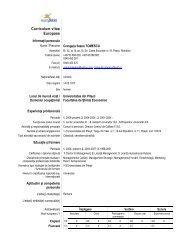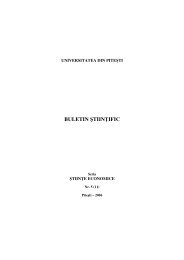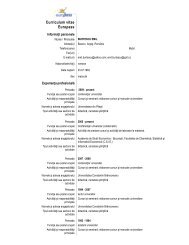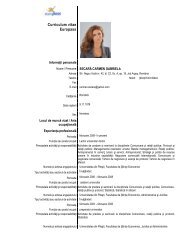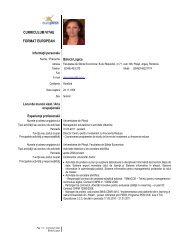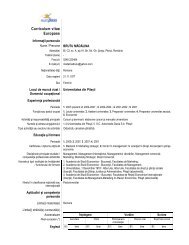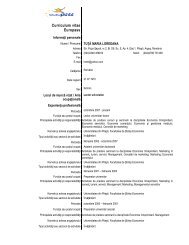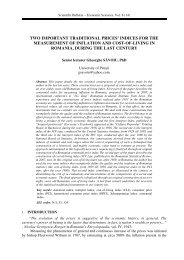buletin Åtiin ific - Facultatea de Stiinte Economice - Universitatea din ...
buletin Åtiin ific - Facultatea de Stiinte Economice - Universitatea din ...
buletin Åtiin ific - Facultatea de Stiinte Economice - Universitatea din ...
- No tags were found...
Create successful ePaper yourself
Turn your PDF publications into a flip-book with our unique Google optimized e-Paper software.
The economic equilibriumFor a competitive (“price – taking”) firm in the product, the rule for a firm’s supplyun<strong>de</strong>r perfect competition is: A profit-maximizing firm will set its production at that level wheremarginal cost equals price:Marginal cost = Marginal revenue = Price or C m = R m = PUn<strong>de</strong>r perfect competition, price equals average revenue. A perfect competitor’s<strong>de</strong>man<strong>de</strong>d curve (P) and its R m coinci<strong>de</strong> as horizontal lines.The short-run and long-run cost functions differ; in the short run, certain factors are heldconstant that are allowed to vary in the long run. The short-run supply curve of competitiveindustry is the horizontal sum of the firm’s supply curves, adjusted for the factor –price effectupon firm’ C m curves at industry output expand or contracts. Each firm’s rising C m curve is itssupply curve. The supply curve of the industry hence represents the marginal cost curve for thecompetitive industry as o whole (4).The <strong>de</strong>mand curve facing a single firm in perfect competition is horizontal (perfectlyelastic) because variations in its production over the range that we need to consi<strong>de</strong>r for allpractical purposes will have a negligible effect on price.If a firm can appreciably affect the market price of its output, then the firm is classified asan “imperfect competitor”. Imperfect competition prevails in an industry whenever individualsellers have some measure of control over the price of output in that industry. Imperfectcompetition does not imply that a firm has absolute control over the price of its product. Howimperfect can imperfect competition? The extreme case would by monopoly: a single seller withcomplete control over an industry. Exclusive monopolies are rare today. Most market structuretoday fall somewhere on a spectrum between perfect competition and pure monopoly: a)oligopoly, here a few sellers of a similar or differentiated supply the industry; b) monopolisticcompetition, where a large number of small firms supply related but somewhat differentiatedproduct (3).We can also see the difference between perfect and imperfect competition in terms ofprice elasticity. For a perfect competitor, <strong>de</strong>mand is perfectly elastic; for an imperfectcompetitor, <strong>de</strong>mand has a finite elasticity.Fig. 3. Imperfect Competition and Price Elasticity DemandPPPPDDDQQa) Infinitely elastic <strong>de</strong>mand b) Elastic <strong>de</strong>mand c) Inelastic <strong>de</strong>mand d) Perfectly inelastic <strong>de</strong>mand(Perfect Competition) (Monopolistic Competition) (Oligopoly) (Monopoly)DQQFor the imperfect competitor, marginal revenue is less than price because of the loss onall previous units of output that will result when the firm is forced to drop its price in or<strong>de</strong>r tosell an extra unit of output. An imperfect competitor faces a downward-sloping <strong>de</strong>mand curve.With <strong>de</strong>mand sloping downward, rule for a firm’s supply un<strong>de</strong>r imperfect competition is: Aprofit-maximizing firm will set it production at that level where marginal cost < price:Marginal cost = Marginal revenue < Price or C m = R m < P36




